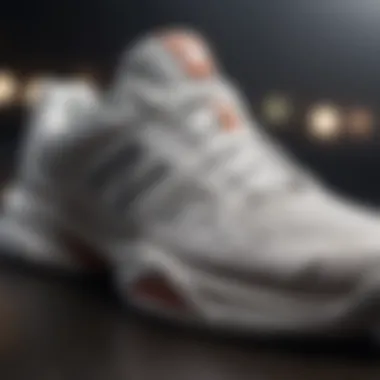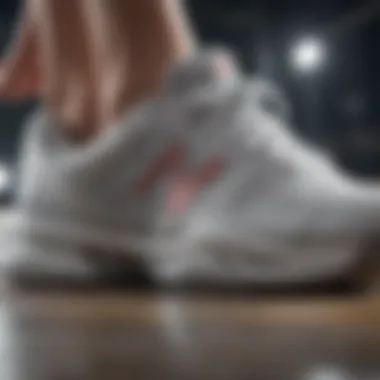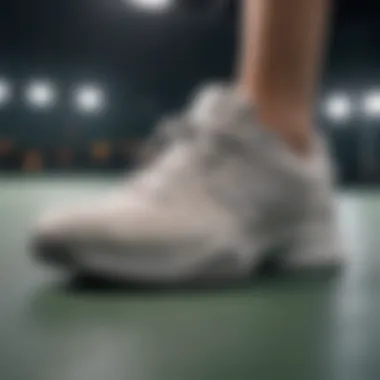Top New Balance Tennis Shoes for Plantar Fasciitis


Intro
For tennis players dealing with plantar fasciitis, selecting the right footwear is crucial. Plantar fasciitis is a common condition characterized by heel pain and discomfort, making it vital for athletes to choose shoes that provide adequate support. New Balance offers a range of tennis shoes that are specifically designed to alleviate stress on the feet while promoting stability and comfort. This article will guide you through the essential features of these shoes, analyze their benefits, and help you make an informed decision when purchasing.
Wellness Insights
Benefits of Regular Exercise
Regular physical activity is essential for maintaining a healthy lifestyle, especially for those with conditions like plantar fasciitis. Engaging in low-impact exercises can strengthen the muscles in the feet, improving overall foot health. Tennis, being both cardiovascular and strength-focused, can enhance fitness without overly straining the feet, provided the right shoes are worn.
Understanding Plantar Fasciitis
Plantar fasciitis occurs when the plantar fascia, a thick band of tissue connecting the heel bone to the toes, becomes inflamed. The condition is often related to repetitive strain, poor footwear choices, or overexertion. Selecting shoes designed for this condition can greatly alleviate pain and support recovery. New Balance tennis shoes are engineered with features specifically catering to these needs.
Key Features of New Balance Tennis Shoes
- Cushioning: Effective cushioning is vital for absorbing impact during play. New Balance utilizes technologies like Fresh Foam and ActevaLite to provide soft landings without sacrificing stability.
- Arch Support: A well-designed arch support is crucial for those with plantar fasciitis. Shoes from New Balance often incorporate responsive arch support that helps distribute weight evenly across the foot.
- Breathability: Proper ventilation can prevent overheating and promote comfort during matches. New Balance shoes often feature engineered mesh uppers for increased airflow.
- Stability Control: Enhanced stability helps prevent excessive movement of the foot. Many models are designed with a stable midsole and firm heel counters to minimize this risk.
"A good tennis shoe is an investment in your health and performance on the court, especially for those suffering from plantar fasciitis."
Popular New Balance Models for Plantar Fasciitis
To aid your shopping experience, consider some of the most recommended New Balance models:
- New Balance 996v4: Known for its lightweight feel and excellent support, this model features a flexible outsole for better responsiveness on the court.
- New Balance 860v11: Provides ample cushioning and support, making it a popular choice among those who need extra stability.
- New Balance Fresh Foam Lav: Offers a combination of plush cushioning and a secure fit, ideal for players seeking comfort without compromising performance.
Epilogue
Understanding the specific needs that arise from plantar fasciitis can guide you in selecting appropriate footwear. New Balance tennis shoes cater to these needs through thoughtful design and innovative technologies. By prioritizing comfort and support, you can enhance your on-court performance and overall foot health.
Understanding Plantar Fasciitis
Understanding plantar fasciitis is vital for anyone who plays tennis and experiences foot pain. This condition can significantly impact performance and overall wellbeing. Recognizing its symptoms and causes can help individuals take appropriate steps to alleviate discomfort. Proper footwear plays a crucial role in managing plantar fasciitis.
What is Plantar Fasciitis?
Plantar fasciitis is an inflammation of the plantar fascia, a thick band of tissue that runs across the bottom of the foot and connects the heel bone to the toes. This condition often results from excessive strain on the fascia, leading to micro-tears, which then cause pain and stiffness. The discomfort typically occurs at the heel or the bottom of the foot, particularly after periods of inactivity such as sleeping or sitting.
Symptoms and Causes
The primary symptom of plantar fasciitis is a sharp pain in the heel, especially with the first steps taken in the morning or after long periods of sitting. Other symptoms may include:
- Discomfort after exercise
- Swelling or tenderness in the heel area
- Increased pain after activities that put stress on the feet
Common causes of plantar fasciitis include:
- Overuse from repetitive activities, especially high-impact sports
- Flat feet or high arches which can alter foot mechanics
- Improper footwear lacking support and cushioning
- Age-related factors, as elasticity in the plantar fascia decreases with time


Impact of Footwear on Plantar Fasciitis
Footwear choices significantly affect the severity of plantar fasciitis. Wearing shoes that lack proper arch support or cushioning compounds the issue by failing to distribute pressure evenly across the foot. Tennis players, in particular, need shoes that provide stability, shock absorption, and adequate support to counteract the intense lateral movements during the game. Proper tennis shoes can help mitigate pain associated with this condition and enhance overall performance.
"Choosing the right footwear is not just about comfort but also a critical factor in managing foot health and preventing injuries."
In summary, understanding plantar fasciitis means recognizing how it affects tennis players and the importance of selecting appropriate footwear. This knowledge lays the groundwork for discussing specific New Balance tennis shoes suitable for individuals with this condition.
New Balance: A Brand Overview
Understanding the significance of New Balance in the realm of tennis shoes, particularly for individuals experiencing plantar fasciitis, is crucial for this article. The brand is well-regarded for its commitment to producing footwear that combines performance and comfort. As tennis requires swift movements and agility, having a reliable shoe can greatly impact both players' performance and foot health.
History and Evolution of New Balance
New Balance has a rich history dating back to its inception in 1906. Originally, it focused on creating arch supports to enhance the comfort of footwear for various occupations. Over the years, the brand evolved, expanding its product lineup to include running and, eventually, tennis shoes. This evolution has witnessed New Balance adopting advanced technologies to address the changing needs of athletes. By continually researching foot biomechanics, New Balance aims to provide optimal support and comfort. This historical perspective helps illustrate the brand’s dedication to addressing foot issues like plantar fasciitis.
Commitment to Comfort and Support
New Balance's commitment to comfort and support is not merely a marketing slogan, but a fundamental principle guiding its design philosophy. The brand focuses on creating shoes that feature:
- Cushioning Technologies: Their EVA and Fresh Foam technologies offer responsive cushioning, crucial for minimizing impact during athletic activities.
- Arch Support: Many New Balance shoes include features that cater specifically to individuals needing extra arch support, an important aspect for those with plantar fasciitis.
- Durability and Stability: Each model is tested for its ability to withstand the rigors of sport while ensuring stability, which is vital during dynamic movements on the tennis court.
"The right footwear can mean the difference between an excellent game and prolonged foot pain."
This alignment of product features with the requirements of athletes helps establish New Balance as a trusted choice among individuals managing foot pain. For anyone experiencing plantar fasciitis, understanding the brand's ongoing pursuit of innovation in comfort technology is essential.
Key Features of Tennis Shoes for Plantar Fasciitis
When considering tennis shoes for individuals coping with plantar fasciitis, specific features emerge as crucial. Shoe design significantly impacts comfort, foot health, and performance on the court. Good footwear can help alleviate pain, support recovery, and prevent further injury.
The following aspects are particularly important when selecting tennis shoes to accommodate plantar fasciitis:
- Cushioning Technology
- Arch Support
- Stability and Traction
- Breathability and Fit
These elements are essential for ensuring that players can perform at their best while managing any discomfort associated with their condition. Let's explore each feature in depth.
Top New Balance Tennis Shoes for Plantar Fasciitis
Choosing the right tennis shoes can significantly affect your comfort and performance, especially for those who experience plantar fasciitis. This condition is characterized by pain in the bottom of the foot and can be aggravated by inappropriate footwear. New Balance offers a range of tennis shoes that balance performance, support, and comfort. In this section, we will detail four models that stand out based on their specifications, user feedback, and overall design. Each shoe is crafted to provide features specifically tailored to alleviate the discomfort associated with plantar fasciitis.
Model One: New Balance 996v4
Overview and Specifications
The New Balance 996v4 stands out due to its combination of lightweight construction and structural support. The shoe features a specialized cushioning system that enhances impact protection. Notably, it incorporates Fresh Foam technology, which provides a soft, yet responsive feel. This blend of cushioning and support is vital for individuals dealing with foot pain. Furthermore, the 996v4 has a lower profile that allows for better ground contact, improving stability on the court.
User Feedback and Performance


Feedback from users indicates that the New Balance 996v4 performs well in various matches. Users often highlight its comfort level during extended play, attributing to its well-balanced cushioning and support. Additionally, many report improved agility due to the shoe's lightweight design, making it a popular choice among athletes. However, there are some comments regarding the width options offered, as some players may struggle to find the ideal fit.
Pros and Cons
Pros of the New Balance 996v4 include its effective cushioning, lightweight feel, and overall stability. On the other hand, the price point may be a consideration, as it sits on the higher end of the market. The limited width options might restrict some users from fully benefiting from its features.
Model Two: New Balance 860v11
Overview and Specifications
The New Balance 860v11 shines with its focus on arch support and stability features. It uses a dual-layer foam for added cushioning while ensuring durability and responsiveness. The shoe's upper ventilation also enhances breathability, keeping the feet cool during intense matches. Its stability features are beneficial for those who overpronate, making it a suitable choice for players with specific foot mechanics.
User Feedback and Performance
User reviews often emphasize the stability of the 860v11. Many have noted a reduction in discomfort during play, attributing this to the unique support structure. Players have also mentioned the shoe's durability, making it a reliable choice for frequent use. Some customers, however, have pointed out that the fit may require a break-in period, which could be a concern for immediate comfort during play.
Pros and Cons
The advantages of the New Balance 860v11 include its exceptional support and cushioning, especially for individuals with specific foot issues. However, the need for a break-in period may deter some users from this model right away. Additionally, its weight could be a slight drawback for those preferring lighter footwear.
Model Three: New Balance Fresh Foam Lav
Overview and Specifications
The Fresh Foam Lav model is designed with a focus on cushion and support. Its unique Fresh Foam midsole offers plush cushioning without sacrificing responsiveness. Additionally, it's constructed with a seamless upper that reduces the likelihood of irritation during prolonged use. This attention to detail makes it particularly appealing for those seeking comfort.
User Feedback and Performance
Users rave about the comfort level of the Fresh Foam Lav, highlighting its adaptability to different court surfaces. The cushioning reportedly absorbs impact well, easing the strain on feet. Many athletes have shared positive experiences regarding its performance in competitive environments. However, some users mentioned that it may lack the stability expected in more rigid designs.
Pros and Cons
The positive aspects of the Fresh Foam Lav include its excellent cushioning and comfort that can benefit those with plantar fasciitis. Yet, it may not provide the high level of support needed for individuals requiring firmer shoe structures.
Model Four: New Balance 797v2
Overview and Specifications
The New Balance 797v2 offers a more traditional tennis shoe experience. It combines a solid base structure with enhanced cushioning. The shoe features a synthetic upper for support and durability, which is essential for a sport that involves rapid movements. Its design appeals to those who prioritize traditional styling while needing functional support.
User Feedback and Performance
Player feedback on the 797v2 includes positive ratings for its overall comfort and classic fit. Many users appreciate how the shoe feels stable without compromising on flexibility, making it suitable for diverse playing styles. Nevertheless, some users have identified that its style might not appeal to those looking for a more modern aesthetic.
Pros and Cons
Pros of the New Balance 797v2 are its durability and classic support features. On the downside, it might not appeal to those who prefer contemporary designs. It's also important to note that while it provides good cushioning, it may not be as cutting-edge as some of the more advanced models in the New Balance lineup.


How to Choose the Right Shoe for Your Needs
Choosing the right tennis shoes is essential, especially for individuals dealing with plantar fasciitis. The right footwear can help alleviate pain and support mobility during play. It is necessary to understand that different foot types require different features in tennis shoes. When selecting a shoe, paying attention to a few critical elements can make a significant difference. In this section, we will explore how to assess your foot type, the importance of trying shoes on, and some shopping tips to ensure you find the best fit.
Assessing Your Foot Type
Knowing your foot type is a crucial first step in finding the right shoe. Feet typically fall into three categories: neutral, flat, or high-arched. Each type has specific requirements. For instance, flat feet usually benefit from additional stability and support in the shoe. Neutral feet can use a wider variety of shoes, while high arches often need extra cushioning to absorb impact.
Here are some questions to consider:
- Do you tend to overpronate or underpronate?
- What is the arch height of your foot?
Understanding these aspects helps direct you towards shoes that offer more comfort and can reduce pressure on the plantar fascia. This assessment should not be overlooked as it sets the foundation for your shoe choice.
Trying Shoes On
Consider Width and Length
When trying shoes on, width and length are significant factors. A shoe that is too tight can create unnecessary pressure, while one that is too loose may lead to instability, increasing the risk of injury. It is essential to measure both the length and width of your feet, as well as consider the specific fit of the shoe model you try. Most brands have different sizing guidelines, so don’t rely solely on your usual size.
The right fit should provide a snug yet comfortable feel without pinching or chafing. A proper fit will contribute to overall comfort, allowing you to focus on playing rather than discomfort.
Look for Comfort and Support
Comfort and support are fundamental characteristics to consider in tennis shoes. When you try on a shoe, walk around to gauge how it feels. Look for cushioning that absorbs impact during play. Many New Balance models incorporate advanced foam technologies that provide superb comfort. Additionally, ensuring that the shoe has adequate arch support can help distribute pressure evenly across the foot, critical for individuals with plantar fasciitis. This aspect can greatly influence your performance on the court and your overall foot health.
Shopping Tips
Online vs. In-Store
Purchasing shoes online can be convenient, offering a wider selection than most stores. However, when dealing with foot conditions like plantar fasciitis, trying shoes in-store may be more beneficial. In-store shopping allows for immediate feedback on fit and comfort. You can walk around, adjust laces, and see how they feel in real time.
Purchasing in-store can also help in receiving personalized assistance from staff who understand the needs related to plantar fasciitis. Despite the temptation of online deals, prioritize comfort and fit above all.
Return Policies to Consider
Finally, consider the return policies of the retailer. If the shoes do not fit properly after trying them outside, having a flexible return policy is advantageous. Check if the store allows returns for worn shoes within a specific timeframe. This feature can protect your investment in case the shoes do not perform as expected. Look for retailers with strong customer service and generous return policies, especially if purchasing online.
"Finding the right footwear is not just about style but about health and performance."
In summary, take the time to assess your foot type, try on multiple pairs, and be aware of your purchase options. This effort is not merely a step in the buying process but a necessary part of ensuring your tennis experience is as pain-free and enjoyable as possible.
Ending
The conclusion of this article highlights the significance of selecting the right tennis shoes, particularly for individuals managing plantar fasciitis. Foot health is paramount for athletes, as inadequate footwear can exacerbate discomfort or lead to further injuries. New Balance offers a range of options that not only address the needs of those suffering from this condition but also enhance overall athletic performance.
Finding Your Ideal Fit
When searching for tennis shoes suitable for plantar fasciitis, finding the perfect fit is essential. A shoe that feels too tight or too loose can affect your game and lead to discomfort. Pay attention to the following criteria:
- Length and Width: Ensure the shoe provides ample space for your toes. A shoe that is too short or narrow can increase pain.
- Arch Support: Look for models that offer specific arch support tailored for your foot structure. This support is vital in alleviating stress on the plantar fascia.
- Cushioning: Optimal cushioning absorbs impact, reducing strain on your feet. Fresh Foam technology from New Balance is a particular example worth considering.
In addition to these aspects, trying on shoes in the afternoon is advisable. The feet often swell throughout the day, so ensuring proper fit at that time can prevent issues later.
Prioritizing Foot Health in Your Athletic Journey
Maintaining foot health is crucial for athletes at any level. Neglecting proper footwear can lead to chronic pain, affecting not only tennis performance but overall lifestyle. Invest in shoes specifically designed for your needs. Here are some benefits of prioritizing foot health:
- Enhanced Performance: Comfortable, supportive shoes can improve your agility and response time on the court.
- Injury Prevention: Proper footwear minimizes the risk of injuries, allowing athletes to train consistently without interruptions.
- Long-term Benefits: Comfortable shoes for tennis contribute overall to foot and body health. This focus can lead to fewer visits to healthcare professionals and a longer athletic career.
In summary, choosing the right New Balance tennis shoes designed for plantar fasciitis matters. It goes beyond comfort; it is an investment in your physical well-being and athletic future.



